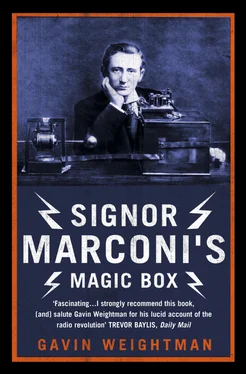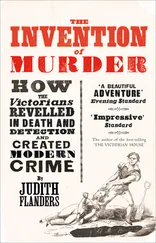Morse code was a set of dots and dashes which represented the letters of the alphabet. The sender pressed a lever on the key, making an electrical connection which in turn activated a circuit connected to a printer which recorded either a dot or a dash. Hold the lever down for a short time, and it was a dot; longer, and it was a dash. It was as simple as that. You could use a Morse key to turn a lightbulb on and off, sending out a visual signal. Ships flashed Morse messages to each other with powerful beams, but could only do this when they were in sight of each other. This was, in a sense, ‘wireless’ communication. So too were the smoke signals used by Native Americans, or jungle drums, or the simple messages sent across the sea from one island to another by striking a resonant shell with a stick. But to receive any of these messages, you had to be able to see or hear the signals. To send a message over a long distance a relay was needed. Europe had such a system in the early nineteenth century, with ‘telegraph’ stations positioned on hills. Large wooden arms were moved to relay semaphore signals from one hill to the next. The invention in the 1840s of the electric telegraph, with Morse keys and receivers connected by cables, revolutionised long-distance communication, and the old hilltop telegraph stations fell derelict.
The great potential of the ‘Hertzian’ waves that Marconi wanted to harness lay in the fact that you did not have to be able to see or hear them to receive them, and you needed no connecting cable to send a signal. How far they could travel through the air Marconi did not know, but that was not the first problem. If you could not hear or see them, how could you detect them? Marconi knew from reading electrical magazines that some ingenious solutions had been found. A French physicist, Edouard Branly, had shown in 1890 that metal filings when scattered in a test tube would not conduct electric current. However, if they were ‘hit’ by an electric charge the filings clung together, and a current could pass through the tube.
The English Professor Oliver Lodge showed in 1893 that the ‘Branly tube’ could act as a detector of Hertzian waves. When a spark was generated the invisible electro-magnetic force would, at a distance, cause metal filings to stick together. Lodge called his version of the Branly tube a ‘coherer’, and showed how it could act as a kind of electronic ‘valve’. If the coherer were put into a circuit with wires from each end, the coherer could turn a current on and off. When the filings lay scattered in the tube no current could pass through it. However, when an invisible Hertzian wave hit the tube, the filings instantly clogged together, allowing an electric current to pass through them and the circuit to be closed. It was like a tap that could be turned on or off from a distance. From a few yards away it was possible to send an invisible, inaudible signal from a ‘transmitter’, which produced Hertzian waves, to a ‘receiver’, which reacted to them, closing a circuit which might light a bulb or ring a bell.
That was more or less the state of the art when Marconi began his experiments in earnest. What he wanted to be able to do was to activate, at a distance, a Morse printer so that each time he pressed his sending key the signals would show up as dots and dashes on a tape. Batteries powered the printer, and the current from them had to flow through the coherer, which would be ‘on’ when the filings inside stuck together, and ‘off’ when they were scattered. It was relatively easy to ring a bell once, but then the metal filings in the coherer stayed stuck together, and the bell would continue to ring even after Marconi had raised the Morse lever and was no longer sending out Hertzian waves. To break the circuit and silence the bell the glass coherer had to be shaken so the metal filings lay scattered once again, and no current could pass through them.
The solution Marconi devised to this problem illustrated his craftsman’s genius. Firstly, he experimented for hours to find the best and most sensitive metal filings to put in the coherer. He then made the glass tube smaller and smaller. To do this he used thermometers, which he remoulded using a hand-bellows, heating the glass with a naked flame. He had to create a vacuum inside these miniaturised coherers to increase their efficiency, and tiny silver plugs were used at either end as terminals. Marconi estimated that to make one little coherer took him a thousand hours.
Once he had his super-sensitive mini-coherer working, Marconi devised a little hammer mechanism which was activated each time he raised the lever on his Morse key and cut off the Hertzian waves. The sharp rap the hammer gave to the tiny coherer loosened the metal filings, cutting off the current and silencing the bell. In the same way, it would turn a Morse printer on and off. Hold the key down for a short time, and you produced a dot. Raise the lever, and the printer stopped. Hold the key down again for longer, and you got a dash. It was incredibly slow, but it worked.
It had been relatively easy to make the transmitter. All that was needed was batteries to provide the current, a coil to bump up the charge, and two brass balls fixed so that there was a small gap between them. Press the Morse key and the current flowed; the electricity jumping between the brass balls created a crackling bluish-yellow spark which generated electro-magnetic waves. These waves travelled at the same speed as light – in fact they were a form of light – but the crest between the waves was much longer, and they could not therefore be seen. During thunderstorms lightning gives out Hertzian waves, which is why radios crackle in response to each flash.
Less than a year after the death of Hertz, Marconi had a working wireless system. But if it was to be of any real use, he had to discover if the sparks of his transmitter could send out waves that a receiver could pick up at a distance of more than a few yards. In the searing heat of the summer of 1895 he first took his boxes outside into the parched fields and neatly trimmed vineyards of the Villa Griffone to discover what the limits of his invention were.
There was nothing in any of the electrical magazines he had read which could help him. All he could do was try different arrangements of transmitter and receiver. Possibly recalling Benjamin Franklin’s experiment with the kite in a thunderstorm, Marconi had the idea that if he raised a wire in the air and put another in the earth, there might be extra power. He was thrilled to discover that this arrangement worked, and he found that the higher the wire, and the more powerful the spark, the further signals would travel. His brother Alfonso moved the receiver and transmitter further and further apart. When the distance reached about a mile, Alfonso was out of sight on the brow of a hill which rose gently behind the villa, and he or one of the farmhands who was helping had to fire a gun to confirm that a signal had got through. Marconi’s father, who had funded his son’s madcap experiments with disgruntled reluctance, was at last impressed enough to discuss how this intriguing invention might be turned into a commercial venture.
From the moment he developed his primitive, home-made wireless system, Marconi felt he was in a race against time. If he could achieve the results he had working in the attic and the grounds of the Villa Griffone, surely someone in a university or a telegraphy company would soon come up with the same thing, or something better. If Marconi failed to make his name and his fortune with this invention, he had nothing to fall back on. His father had wanted him to join the Italian navy, but Guglielmo, preoccupied with his experiments, had failed the examinations for entry to the naval college.
Now old Giuseppe accepted that his youngest son’s future, if he had one, was with the odd bits of wire and batteries strewn about the attic of the villa, and the strange-looking antennae erected in the grounds of the estate. But who would be interested in Guglielmo’s magic boxes? And would anyone invest in them, so that the family fortune would not dwindle away? The Italian ministry of posts? Or the navy, perhaps? According to Marconi family legend, approaches were made, but after a wait of several months they received a polite refusal. This is possible, although no records have been found of any contacts with the government. Perhaps the story was invented later to protect Marconi’s reputation as a staunch Italian patriot. As it was, Guglielmo and his mother were soon on their way to London, where there was a much greater chance that his invention might be taken up, with the help of Annie Marconi’s many wealthy and influential relatives.
Читать дальше












